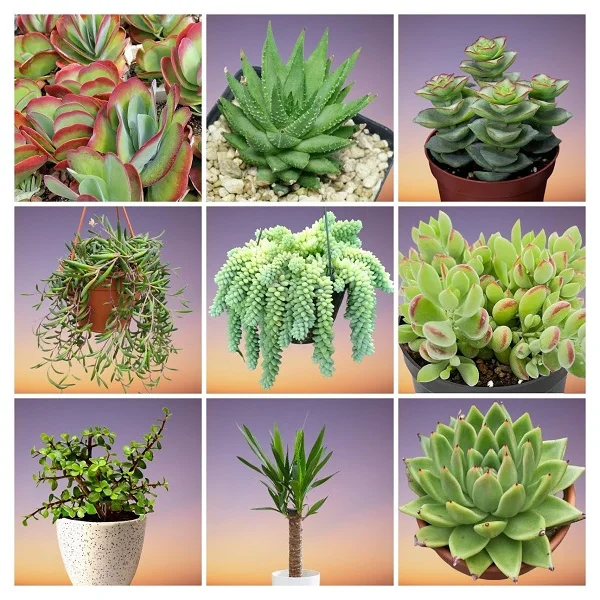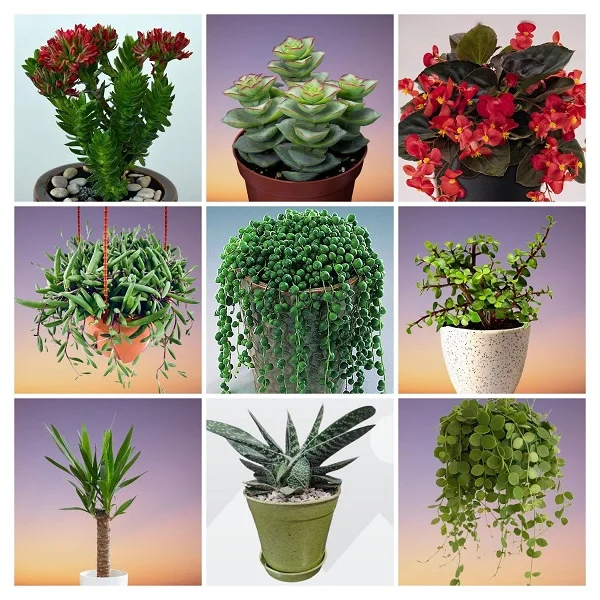String of Rubies Plant (Othonna capensis) Indoor Care, Propagation, Problems & Remedies
Some links in this post may be affiliate links
String of Rubies Plant (Othonna capensis) blossoms in very bright light, average warmth, moderate humidity and moderately moist, fertile, well-drained soil coupled with two feedings in the growing season.
Othonna capensis is highly sought after for its striking color transformation and low-maintenance nature. Understanding its specific indoor care needs ensures its vibrant color, healthy growth, and long lifespan.
String of Rubies Plant also called String of Pickles Plant, Little Pickles Plant or Ruby Necklace is one of the popular string of plants and is characterized by thin, oval-shaped leaves and reddish-purple stems.
The bean-shaped leaves turn a bright ruby red when the plant is grown under bright sunshine giving it the common name, Ruby Necklace. The flowers are a bright yellow color.
In its natural habitat, String of Pickles Plant grows as a trailer, with stems trailing on the ground, rooting where they touch and forming dense mats.
The trailing stems are spectacular when they cascade downwards beautifully in a hanging basket or on a pedestal. Little Pickles Plant is among the best hanging succulent plants for indoors.
The odd shaped leaves is an adaptation to arid conditions and allows for the storage of water while exposing minimum surface area to the dry desert air which greatly reduces water loss.
The fleshy leaves and stems store water, which allows the plant to go for a considerably long period without being watered. Ruby Necklace is one of the best drought-tolerant plants for the home, office and other spaces.
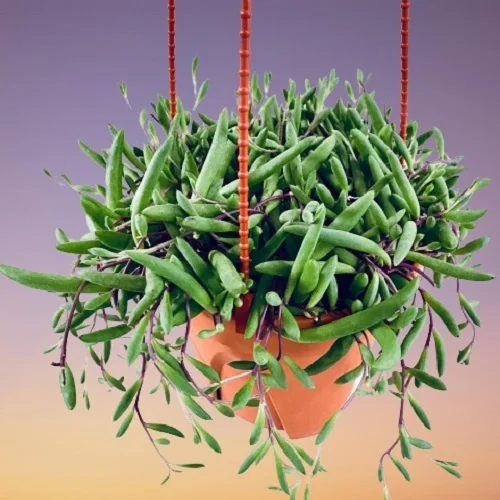
Botanical name: Othonna capensis
Synonmy: Othonna crassifolia
Family: Asteraceae
Common names: String of Rubies Plant, String of Pickles, Ruby Necklace, Little Pickles
Origin
Othonna capensis is a trailing, perennial, succulent vine native to the drier parts of Southwest Africa.
Is Othonna capensis poisonous?
String of Rubies Plant is non-toxic to both humans and pets. Othonna capensis is a safe for children, cats, dogs and other pets in the home.
Where to Buy
If you are looking to add this plant to your addition, String of Pickles Plants are available online on Etsy (Link to Etsy).
How do you care for Othonna capensis indoors?
To care for Othonna capensis indoors, give it very bright light with at least 6 hours of sunlight, average warmth of 20-270C, moderate humidity of 50-55% and moderately moist, fertile, well-drained soil coupled with two feedings during the growing season.
String of Rubies Plant care requires regular pruning to keep it neat as well as rejuvenate growth. Frequent repotting is not needed as it has a small root system. Keep reading for more on the best growing conditions and how to achieve them.
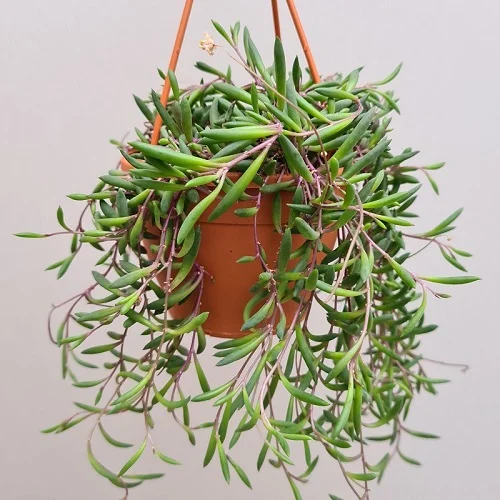
Light Requirements
How much light does String of Rubies Plant need?
String of Rubies Plant grows best in bright light with at least 6 hours of morning or late afternoon sunlight per day. Keep it away from hot midday sunshine to avoid scorching.
Bright sunshine enhances a bright, ruby-red color on the leaves and stems. Low light results in a leggy growth with wide spaces btween the leaf nodes and undersized leaves.
Therefore, where the natural lighting is not adequate, consider using a grow light to supplement it.
Regularly rotate the pot to ensure that the plant receives enough light on all sides for uniform growth and to prevent legginess.
Watering
How often should you water a Ruby Necklace Plant?
Do not water your Ruby Necklace on a schedule to avoid either underwatering or overwatering which is detrimental to the growth of the plant.
Water your Ruby Necklace Plant thoroughly until water comes out through the drainage holes in spring and summer while allowing the top 2-3 inches of the soil to dry out between waterings. Keep the soil moderately moist but not soggy to avoid rotting.
Significantly decrease watering in fall and winter to maintain the soil barely moist as growth is minimal at this time. Do not allow the soil to dry out completely to prevent wilting.
Make sure the pot has a drainage hole and the soil is free-draining to avoid soggy soil which can lead to rotting. Avoid wetting the foliage during wetting as it can encourage fungal diseases; you may water from the bottom.
Temperature and Humidity
Othonna capensis requires an average warmth of 20-270C during the growing season to thrive. Keep it away from drafts to prevent temperature flactuations as they can cause leaf drop.
String of Rubies Plant has no need for extra humidity. Average humidity of 50-55% is ideal for this plant. Ensure that there is good air flow to prevent fungal disease infestations.
Potting Soil
The best soil for Othonna capensis is a rich, loose and free-draining to avoid waterlogging and root-rot. Cactus and succulents potting soil is ideal for this plant.
Fertilizer
Feed your String of Rubies Plant with a balanced, liquid fertilizer twice during the growing season (spring and summer). The plant is not a heavy feeder so be careful when feeding; too much fertilizer may result in leggy growth.
Do not feed in the cold season (fall and winter) as growth is minimal at this time. Feeding at this time can lead to fertilizer burn and death of the plant.
Repotting
Othonna capensis has a small root system so frequent repotting is not necessary. Repot the plant at the beginning of the growing season only when it becomes crowded in its current pot.
Use a pot 1 size larger than the current one that has a drainage hole to prevent waterlogging which can lead to rotting.
A shallow pot is ideal for this plant as it has a small root system. Be careful not to bury the stems to prevent rotting. Take a look at these succulents pots available on Amazon.
Pruning
Pruning String of Rubies Plant involves:
- Removal of dead leaves and stems to keep it neat as well as minimize diseases and pests.
- Trimming the stems at the beginning of the growing season if they become straggly to rejuvenate growth.
Othonna capensis Propagation
String of Rubies Plant (Othonna capensis) propagation is done at the beginning of the growing season from stem cuttings.
How to propagate String of Rubies Plant from stem cuttings
- Take 4-6 inches stem cuttings from a healthy plant. Ensure each cutting has 2-3 leaf nodes as this is where rooting will occur.
- Allow the cuttings to dry (callus) for about 5-7 days to avoid rotting.
- Fill the rooting cointainer or pot with quality succulents soil and moisten it moderately.
- Once callused, press the cut end of the cutting into the soil or lay the cuttings on top of the soil and lightly press the leaf nodes into the soil.
- Place the set-up in a brightly-lit, warm place away from direct sunlight.
- Maintain the soil moist until the cuttings are well rooted. Roots develop in 3-4 weeks.
- Allow substancial growth before transplanting the new plants to individual pots after which you can begin routine care.
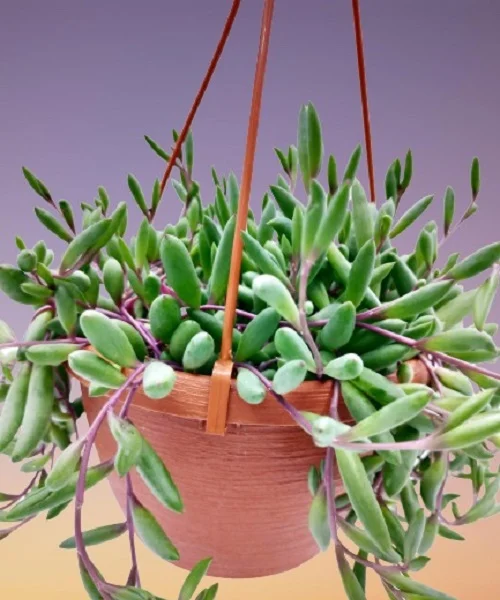
Othonna capensis Problems & Solutions
String of Rubies Plant (Othonna capensis) problems are plant dying, dropping leaves, wilted leaves, leggy stems, brown and dry leaf spots, pests and diseases among others. Keep reading for more on these problems and their remedies.
Plant dying
Why is my String of Rubies Plant dying?
Your String of Rubies Plant is dying due to overwatering, underwatering, overfeeding, hot sunshine, poor soil quality, being extremely pot-bound, pests and diseases among others.
Check out these 11 reasons why String of Rubies Plant is dying and how to fix them.
Dropping leaves
Dropping leaves on String of Rubies Plant is due to inconsistent watering, improper feeding, temperature stress, poor soil, diseases and pests among others.
Here are 12 reasons String of Rubies Plant is dropping leaves and their remedies.
Wilted leaves
Wilted leaves on String of Rubies Plant is caused by inconsistent watering and temperature stress.
How to fix it
Inconsistent watering: Water when the top 2-3 inches of soil feel dry to touch but do not allow the soil to dry out completely.
Temperature stress: Keep the plant away from drafts coming from AC units, heat sources, windy doors and others.
Leggy stems
Leggy stems on String of Rubies Plant are due to too little light and overfeeding.
Too little light: Move the plant to a brighter spot where it will receive bright light with 6-8 hours of direct sunlight or instal grow lights if the natural lighting is not adequate.
Overfeeding: The plant is a light feeder; feed it twice in spring and summer.
Brown, dry leaf spots
Brown, dry leaf spots on String of Rubies Plant are caused by underwatering. Water the plant when the top 2-3 inches of the soil to dry out and do not allow the soil to dry out completely.
Pests
Common pests on String of Rubies Plant are mealybugs, aphids, scale insects and spider mites infestations. These sap-sucking insects attack the new growth from where they suck the plant sap, causing wilting, yellowing and leaf drop.
How to fix it
Isolate the affected plant and treat it with neem oil and insecticidal soap as per the manufacturer's instructions.
Diseases
String of Rubies Plant is prone to powdery mildew, leaf spot disease and basal stem-rot disease.
Powdery mildew which is characterized by spotting or coating of the leaf surface with a white powdery deposit.
How to fix it
- Remove the badly affected parts and discard or burn to reduce spread to other parts of the plant.
- Spray the plant with a systemic fungicide or lightly dust the leaves with a sulphur compound.
- Improve the air circulation for your plant to minimize the disease infestation.
Leaf spot disease is characterized by brown, moist spots on the leaves. In a serious attack the spots can enlarge and merge, killing the whole leaf.
How to fix it
- Remove and burn the affected parts to reduce the risk of spread to the rest of the plants.
- Spray the affected plant with a systemic fungicide and ensure to cover all the parts with the fungicidal solution.
- Keep the plant on the dry side, do not mist it and ensure good air flow.
Basal stem-rot disease which is promoted by overwet conditions and is indicated by a rotting base and stem collapse.
How to fix it
- Use the upper stem to propagate new plants and discard the infected parts.
- Reduce frequency of watering in fall and winter to reduce occurence of the disease.
Conclusion
String of Rubies Plant (Othonna capensis) is an easy-care succulent that thrives indoors with proper light, well-draining soil, and minimal watering. Whether you are propagating new plants or troubleshooting common issues, this guide provides everything you need to enjoy this vibrant trailing plant in your home.
You liked it? Share on social media.
Related Content
Amazon Associates Disclosure
Homeplantsguide.com is a participant in the Amazon Services LLC Associates Program, an affiliate advertising program designed to provide a means for sites to earn advertising fees by advertising and linking to amazon.com.



